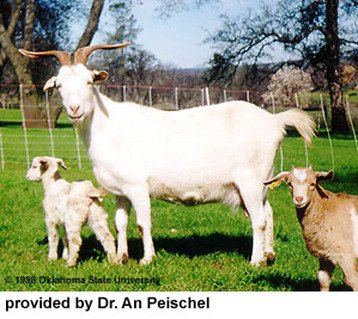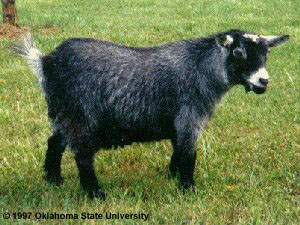Breeds of Goats
The main breeds of goats that we see in the U.S. include the Boar, Kiko, Spanish Meat goat, Pygmy, Tennessee Fainting Goat, Angora, LaMancha, Saanan, French Alpine, Oberhasli, Nubian, Toggenburg, Nigerian Dwarf and the Sable. These are the breeds that our 4-H students should be familiar with. The descriptions and images in this skillathon manual come from http://www.ansi.okstate.edu/breeds/goats. If you access that site you will find many more breeds as well as much more detailed descriptions of the breeds.
Boar

This South African breed probably resulted from crossbreeding of native goats raised by Bantu tribes and various European and Asian goats brought in by Dutch immigrants. Bred true for high growth rate, muscular carcasses, good fertility, and short hair combined with a very distinct color pattern (white with red head). Boer goats were introduced into the US in the early 1990’s. Under good nutritional conditions, Boer goat crossbreds produce outstanding weight gains and carcasses.
Kiko

Produced in New Zealand by taking feral does that exhibited good meat conformation and breeding them with Saanen and Nubian bucks to increase their milk yield and butterfat content. Similar ears to Spanish goats but usually larger framed. Often white like their ancestors.
Spanish Meat Goat

Descendants of goats brought to the US by early New England Settlers. Very tough, rather small goats. They came in almost any color and ore usually left horned. Ears are pendulous but shorter than Nubian’s. Produce a cashmere undercoat in the winter
Pygmy Goat

Originally called the Cameroan Dwarf Goat. A full coat of straight, medium-long hair, which varies in density with seasons and climates. All body colors are acceptable. The predominate coloration is a grizzled (agouti) pattern produced by the intermingling of light and dark hairs, of any color.
Tennessee Fainting Goat

Wooden leg goats or “stiff leg.” Indigenous to the US. Myotonic means when they are excited or frightened they “lock up” and often fall over (faint) and lie stiff for a few seconds. Selected for meat production, heavy rumped, deep chested animals. Most are black and white but multi colors are not uncommon. Easy kidders and good milk production.
Angora Goat

Originated in the district of Angora in Asia Minor. Most valuable characteristic is the value of the mohair that is clipped. Average goat shears about 5.3# per shearing twice a year. Different from wool, mohair has a much smoother surface and very thin, smooth scale. A horned goat, males have a pronounced spiral to their horn and females have short, smaller horns. They are classified by the type of ringlet or lack hair in which the hair grows.
French Alpine

Originated in the Alps. Size and production of milk are more important than color pattern. No distinct color has been established; however the colors are described by specific terms. Hardy adaptable animals that thrive in any climate while maintaining good health and excellent production. Short haired, bucks usually have a roach of long hair along the spine. Beard of males is pronounced. Ears are medium size, fine textured and preferably erect.
LaMancha

Originated in Oregon by Mrs. Eula Frey. Excellent dairy temperament and can withstand a great deal of hardship and still produce milk well. Established itself in milk production with high butterfat. Straight face with ears being the distinctive breed characteristic. Two types of ears: gopher ear and elf ear. Any color or combination of colors is acceptable. Hair is short, fine and glossy.
Nubian

Developed in England by crossing British goats with bucks of African and Indian Origin. All purpose goats, used for meat, milk, and hide production. An “aristocratic” goat and has very long, wide and pendulous ears that extend at least an inch beyond the muzzle when held flat to the face. The head is the distinctive breed characteristic, with a Roman nose. The hair is short, fine and glossy. Any color or colors, solid or patterned is acceptable.
Nigerian Dwarf

A miniature goat of West African Origin. It’s conformation is similar to that of the larger dairy goat breeds. The parts of the body are in balanced proportion. The nose is straight. The ears are upright. The coat is soft with short to medium hair. Any color or combination of colors is acceptable, though silver agouti (roan) is considered a moderate fault. Animals are disqualified from the show ring for being over-sized for the breed standard. Ideal height for does is 17”-19” and for bucks 19”-20”
Oberhasli

A Swiss dairy goat. Medium size, vigorous and alert in appearance. Color is chamois (Bay) ranging from light to deep red bay. Markings include two black stripes down the face from above the eyes to a black muzzle; forehead nearly all black , black stripes from the base of each ear coming to a point just back of the poll and continuing along the neck and back as a dorsal stripe to the tail; a black belly and udder; black legs below the knees and hocks; ears black inside and bay outside. Straight face.
Sannan and Sable

This dairy goat originated in Switzerland, in the Saanen Valley. Heavy milk producers and yield 3-4% milk fat. Medium to large in size with rugged bone and plenty of vigor. The only difference between the two breeds is the color. The Saanen being solid white or light cream in color, with white preferred. The Sable having black or grey markings. Ears should be erect and alertly carried, preferably pointing forward. Face should be straight or dished. Sensitive to excessive sunlight and performs better in cooler conditions.
Toggenburg

The oldest known dairy goat breed. Medium in size, vigorous, and alert in appearance. Hair is short or medium length, soft, fine and lying flat. Its color is solid varying from light fawn to dark chocolate with no preference. Distinct white markings: white ears with dark pot in middle, two white stripes down the face from above each eye to the muzzle; hind legs white from hocks to hooves; forelegs white from knees downward with dark lien (band) below the knee; white triangle on either side of the tail; white spot present at root of wattles. Performs best in cooler conditions. Noted for excellent udder development and high milk production. Face should be straight or dished.


